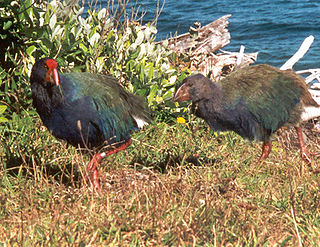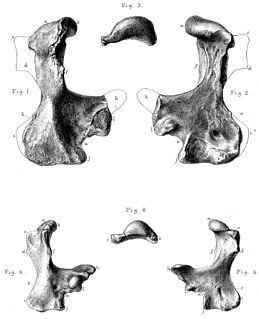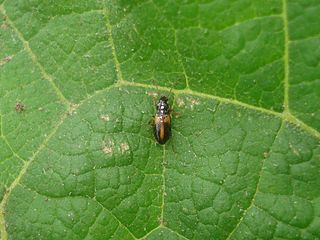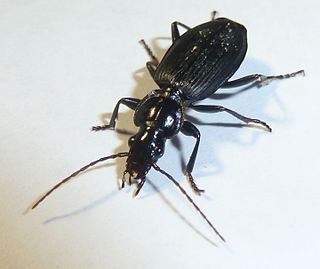The Mesozoic Era meaning "middle life" is the middle of the three geological eras of the Phanerozoic Eon. It lasted from about 252 to 66 million years ago. It is also called the Age of Reptiles and the Age of Conifers.

Glareolidae is a family of birds in the wader suborder Charadrii. It contains two distinct groups, the pratincoles and the coursers. The atypical Egyptian plover, traditionally placed in this family, is now known to be only distantly related.

The Cuban solenodon, or almiqui, is a species of eulipotyphlan endemic to Cuba. It belongs to the family Solenodontidae along with a similar species, the Hispaniolan solenodon. The solenodon is unusual among mammals in that its saliva is venomous.

Sabine's gull, also known as the fork-tailed gull or xeme, is a small gull. Its generic placement is disputed; some authors treat it as the sole species in the genus Xema as Xema sabini, while others retain it in the genus Larus as Larus sabini.

The Pterygota are a subclass of insects that includes the winged insects. It also includes insect orders that are secondarily wingless.

Harpalinae is a huge subfamily of ground beetles that contains 20,000 species or ~6,400 spp. in 24 tribes worldwide, according to others. A rarely used common name for the subfamily is the harp beetles. The Harpalinae contain the most apomorphic ground beetles, displaying a wide range of forms and behaviors. Some are, rare among ground beetles, omnivores or even herbivores.

In paleontology, a Lazarus taxon is a taxon that disappears for one or more periods from the fossil record, only to appear again later. Likewise in conservation biology and ecology, it can refer to species or populations that were thought to be extinct, and are rediscovered. The term Lazarus taxon was coined by Karl W. Flessa & David Jablonski in 1983 and was then expanded by Jablonski in 1986. Wignall and Benton defined Lazarus taxa as, 'At times of biotic crisis many taxa go extinct, but others only temporarily disappeared from the fossil record, often for intervals measured in millions of years, before reappearing unchanged'. Earlier work also supports the concept though without using the name Lazarus taxon, like work by Christopher R. C. Paul.
Protognathosaurus is a genus of herbivorous dinosaur from the Middle Jurassic. It was a sauropod found at Dashanpu in Sichuan in what is present-day China.

Anthia is a genus of the ground beetle family (Carabidae). Species of Anthia can spray a jet of formic acid up to 30 centimetres (12 in), which if not treated, can cause blindness in animals which harass the beetles.

The evolution of spiders has been ongoing for at least 380 million years. The group's origins lie within an arachnid sub-group defined by the presence of book lungs ; the arachnids as a whole evolved from aquatic chelicerate ancestors. More than 45,000 extant species have been described, organised taxonomically in 3,958 genera and 114 families. There may be more than 120,000 species. Fossil diversity rates make up a larger proportion than extant diversity would suggest with 1,593 arachnid species described out of 1,952 recognized chelicerates. Both extant and fossil species are described annually by researchers in the field. Major developments in spider evolution include the development of spinnerets and silk secretion.
Miomoptera is an extinct order of insects. Although it is thought to be a common ancestor of all holometabolous insects, because no smooth transition between Miomoptera and other holometabolous insect orders is known, it is considered to be in a separate order unto itself.

Megalibgwilia is a genus of echidna known only from Australian fossils that incorporates the oldest-known echidna species. It is also the only extinct echidna genus. The genus ranged from the Miocene until the late Pleistocene, becoming extinct about 50,000 years ago. Megalibgwilia species were more widespread in warmer and moist climates. The extinction can be attributed to increasing aridification in Southern Australia.

Glover's Wood is a 74.5-hectare (184-acre) biological Site of Special Scientific Interest east of Charlwood in Surrey. It is a Nature Conservation Review site, Grade 2.

Tipula is a very large insect genus in the fly family Tipulidae. They are commonly known as crane flies. Worldwide there are well over a thousand species.

Protelytroptera is an extinct order of insects thought to be a stem group from which the modern Dermaptera evolved. These insects, which resemble modern Blattodea, or Cockroaches, are known from the Permian of North America, Europe and Australia, from the fossils of their shell-like forewings and the large, unequal, anal fan. None of their fossils are known from the Triassic when the morphological changes from Protelytroptera to Dermaptera presumably took place.

Acupalpus is a genus of insect-eating beetle species. Its representatives are found across Europe, Asia, and North America.

Hystrichopus is a genus of inconspicuous, nocturnal beetles in the family Carabidae. The genus is native to the greater part of the Afrotropics and locally to the southern Palaearctic.

Platyninae is a subfamily of ground beetles. Occasionally it was treated as a tribe Platynini of subfamily Harpalinae, particularly when this was circumscribed loosely.

Dryococelus australis, commonly known as the Lord Howe Island stick insect or tree lobster, is a species of stick insect that lives on the Lord Howe Island Group. It is the only member of the monotypic genus Dryococelus and was thought to be extinct by 1920, only to be rediscovered in 2001. It is extirpated in its largest former habitat, Lord Howe Island, and has been called "the rarest insect in the world", as the rediscovered population consisted of 24 individuals living on the small islet of Ball's Pyramid.

Scaritinae is a subfamily of beetles in the family Carabidae, containing the following genera:
















